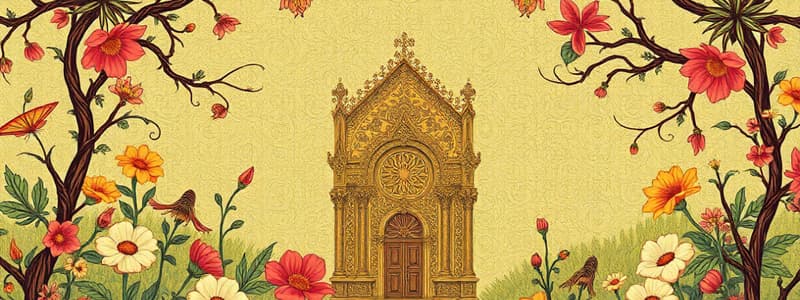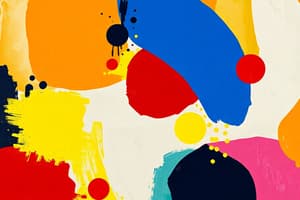Podcast
Questions and Answers
What is the primary purpose of burnishing in printmaking?
What is the primary purpose of burnishing in printmaking?
- To transfer an image through pressure (correct)
- To analyze artwork
- To carve the printing matrix
- To create a multicolor print
The Group of Seven was a collective of only six Canadian artists.
The Group of Seven was a collective of only six Canadian artists.
False (B)
What are the four steps involved in art critique?
What are the four steps involved in art critique?
Describe, Analyze, Interpret, Judge
The Group of Seven is known for painting Canadian ______.
The Group of Seven is known for painting Canadian ______.
Match the watercolour painting techniques with their descriptions:
Match the watercolour painting techniques with their descriptions:
Which tool is primarily used for rolling out ink before it is applied to the matrix?
Which tool is primarily used for rolling out ink before it is applied to the matrix?
A relief print is made by carving away areas you want to be printed.
A relief print is made by carving away areas you want to be printed.
What is an 'Artist Proof' in printmaking?
What is an 'Artist Proof' in printmaking?
The process of making artwork by printing on paper is called __________.
The process of making artwork by printing on paper is called __________.
Match the tools with their usage in printmaking:
Match the tools with their usage in printmaking:
Which of the following describes a linocut?
Which of the following describes a linocut?
Registration guides are used to ensure accurate placement of the inked matrix and paper in printing.
Registration guides are used to ensure accurate placement of the inked matrix and paper in printing.
The __________ is the negative of your design in printmaking.
The __________ is the negative of your design in printmaking.
Which of the following is NOT a technique used in colored pencil drawing?
Which of the following is NOT a technique used in colored pencil drawing?
Sculpture in the round is meant to be viewed from only one side.
Sculpture in the round is meant to be viewed from only one side.
Which of the following is NOT a property of color?
Which of the following is NOT a property of color?
Organic shapes are considered regular shapes.
Organic shapes are considered regular shapes.
What primary materials were used in the earliest sculptures?
What primary materials were used in the earliest sculptures?
The _____ technique involves layering colored pencil to achieve a desired color saturation.
The _____ technique involves layering colored pencil to achieve a desired color saturation.
What is the definition of form in art?
What is the definition of form in art?
A _____ is a line that describes the edge of an object.
A _____ is a line that describes the edge of an object.
Match the type of sculpture to its description:
Match the type of sculpture to its description:
Match the following types of texture with their descriptions:
Match the following types of texture with their descriptions:
Which process involves removing excess material from a medium?
Which process involves removing excess material from a medium?
The Middle Eastern region of Mesopotamia primarily used sculptures for decorative purposes.
The Middle Eastern region of Mesopotamia primarily used sculptures for decorative purposes.
What is an armature used for in sculpture?
What is an armature used for in sculpture?
Positive space refers to the areas around a subject in a composition.
Positive space refers to the areas around a subject in a composition.
What is the purpose of a value scale?
What is the purpose of a value scale?
A ___ drawing captures the essential gesture and pose of the model.
A ___ drawing captures the essential gesture and pose of the model.
Which of the following is NOT a type of shading method?
Which of the following is NOT a type of shading method?
Match the shading methods with their descriptions:
Match the shading methods with their descriptions:
Which pencil grade indicates the darkest mark?
Which pencil grade indicates the darkest mark?
Contour lines are solid and continuous lines that define the shape of an object.
Contour lines are solid and continuous lines that define the shape of an object.
Flashcards
Line Weight
Line Weight
The way a line's thickness varies, from thin to thick. It can add emphasis or create shape.
Contour Lines
Contour Lines
Lines that describe the outer edge of an object. They create outlines.
Cross-Contour Lines
Cross-Contour Lines
Lines that move across the surface of an object, showing its shape and form. They are similar to contour lines.
Geometric Shape
Geometric Shape
Signup and view all the flashcards
Organic Shape
Organic Shape
Signup and view all the flashcards
One-Point Perspective
One-Point Perspective
Signup and view all the flashcards
Perspective
Perspective
Signup and view all the flashcards
In the Round (Freestanding)
In the Round (Freestanding)
Signup and view all the flashcards
Relief Sculpture
Relief Sculpture
Signup and view all the flashcards
Modeling
Modeling
Signup and view all the flashcards
Carving
Carving
Signup and view all the flashcards
Casting
Casting
Signup and view all the flashcards
Assembling (Constructing)
Assembling (Constructing)
Signup and view all the flashcards
Value
Value
Signup and view all the flashcards
Value Scale
Value Scale
Signup and view all the flashcards
Space
Space
Signup and view all the flashcards
Positive Space
Positive Space
Signup and view all the flashcards
Negative Space
Negative Space
Signup and view all the flashcards
Blind Contour
Blind Contour
Signup and view all the flashcards
Gesture Drawing
Gesture Drawing
Signup and view all the flashcards
What is a reduction print?
What is a reduction print?
Signup and view all the flashcards
What is burnishing?
What is burnishing?
Signup and view all the flashcards
Who were the Group of Seven?
Who were the Group of Seven?
Signup and view all the flashcards
What is glazing in watercolour?
What is glazing in watercolour?
Signup and view all the flashcards
What is wet-on-wet in watercolour?
What is wet-on-wet in watercolour?
Signup and view all the flashcards
Printmaking
Printmaking
Signup and view all the flashcards
Print
Signup and view all the flashcards
Linocut
Linocut
Signup and view all the flashcards
Relief Print
Relief Print
Signup and view all the flashcards
Gouge/Carving Tool
Gouge/Carving Tool
Signup and view all the flashcards
Baren
Baren
Signup and view all the flashcards
Brayer
Brayer
Signup and view all the flashcards
Artist Proof
Artist Proof
Signup and view all the flashcards
Study Notes
Art Exam Notes - Elements and Principles
- Elements: Spaceships Flying Through Space Look Very Cool (Line, Shape, Color, Texture, Form, Value, Space)
- Principles: BRUCE PM (Emphasis, Rhythm, Pattern, Contrast, Unity, Balance, Movement)
Line
- Types: Vertical, Horizontal, Diagonal, Zigzag, Curved
- Line Weight: Varying thickness of lines (thin to thick)
- Contour Line: Follows the edges of an object
- Cross-Contour Line: Describes the form of an object
- Refer to GC (Graphic Construction) for more clarification.
Shape
- Types: Geometric (triangle, square, circle) and Organic (irregular shapes).
Color
- Properties: Hue (color name), Value (lightness/darkness), Intensity (brightness/dullness).
Texture
- Types: Actual (physical feel of surface) and Visual (implied texture created with line, shading, and color)
Form
- Definition: Three-dimensional, enclosed space (length, width, and depth)
- Types: 3-dimensional (sculptures) and illusionary (2-dimensional forms created through value adjustments)
Value
- Definition: Lightness or darkness of a color or neutral (creates changes in form)
- Scale: Gradient from light to dark
Space
- Definition: Areas around, between, and within a composition
- Types: Positive (areas of focus) and Negative (areas surrounding focus)
Drawing Tools/Vocab
- Kneaded Eraser
- Blending Stomp
- Pencil Grades: 2H, 2B, F, etc. (H=Hardness, B=Blackness)
- F=Firm
Cast Shadow
- First, locate the light source.
- Draw lines extending from the light source through the edges of the object.
- Create the shape of the shadow that touches the lines from the first step.
Angle
- Closer light source = larger shadow.
- Lower angle light source = longer shadows.
- Higher angle light source = shorter shadows.
Shading Methods
- Hatching
- Cross Hatching
- Scribbling
- Pointillism/Stippling
Colour Harmonies
- Primary Colors: Red, Yellow, Blue
- Secondary Colors: Orange, Green, Purple
- Tertiary Colors: Mixtures of primary and secondary colors.
- Colour Schemes: Monochromatic, Analogous, Complementary, Split Complementary, Triadic, Tetradic, Square.
Contour Drawing
- Outlines objects using continuous lines focusing on the edges.
Gesture Drawing
- Capturing the action, form, and pose in a brief time period.
One-Point Perspective
- Uses a single vanishing point on the horizon line to create depth.
- Vanishing Point
- Horizon Line
- Frontal Planes
Coloured Pencil Techniques
- Pressure
- Layering
- Pencil Angle
- Sharpness of Pencil
- Circling Technique
- Burnishing Technique
Printmaking
-
Relief Print: Carve away areas; ink applied to raised areas.
-
Tools: Brayer, Block Printing Ink, Knife, Baren
-
Matrix: Surface etched/cut for printing (e.g., linoleum block)
-
Print: Impression from the matrix.
-
Edition: Number of prints from a single block.
Sculptural Process
- Armature: Framework (e.g., wire, metal pipes)
- Carving: Subtracting material.
- Casting: Use of molds to form objects.
- Modelling: Shaping materials (e.g., clay, wax).
- Assembling: Combining various components.
Sculpture/History of Sculpture
- In the Round: Freestanding sculptures.
- Relief: Sculpture on a flat surface.
- Closed Composition: Solid and opaque; no open spaces.
- Open Composition: Uses negative space.
Acrylic Paint
- Made through pigment mixing in liquid.
- Dry darker acrylic = waterproof.
- Suitable for various mediums including flexible surfaces, or rubbery surfaces.
Printmaking Vocabulary
- Printmaking: Process of making art by printing onto paper, creating multiple copies of the image.
- Print: A picture or design printed from a block or plate.
- Linocut: Relief print made on linoleum using a sharp cutter.
- Relief Print: Ink goes on top of raised areas of the matrix.
Types of Sculpture
- Freestanding: Sculptures standing on their own separate base.
- Relief: Sculptures that project outwards from a background plate; usually on a flat or almost flat surface.
Art Critique
- Describe: Elements and composition
- Analyze: How artists use the elements and principles.
- Interpret: Understanding message/meaning.
- Judge: Evaluate artistic merit and quality.
Watercolour
- Prepare paper before use (stretch/avoid wrinkles by folding)
- Thin layer of water is followed by drying with a hair dryer.
- Water colour pigment is vibrant.
Studying That Suits You
Use AI to generate personalized quizzes and flashcards to suit your learning preferences.
Related Documents
Description
Explore the essential elements and principles of art, including line, shape, color, and texture. Understand the types of lines, shapes, and their properties, which essential for creating impactful artworks. This quiz will help reinforce your knowledge and prepare you for your upcoming exam.




